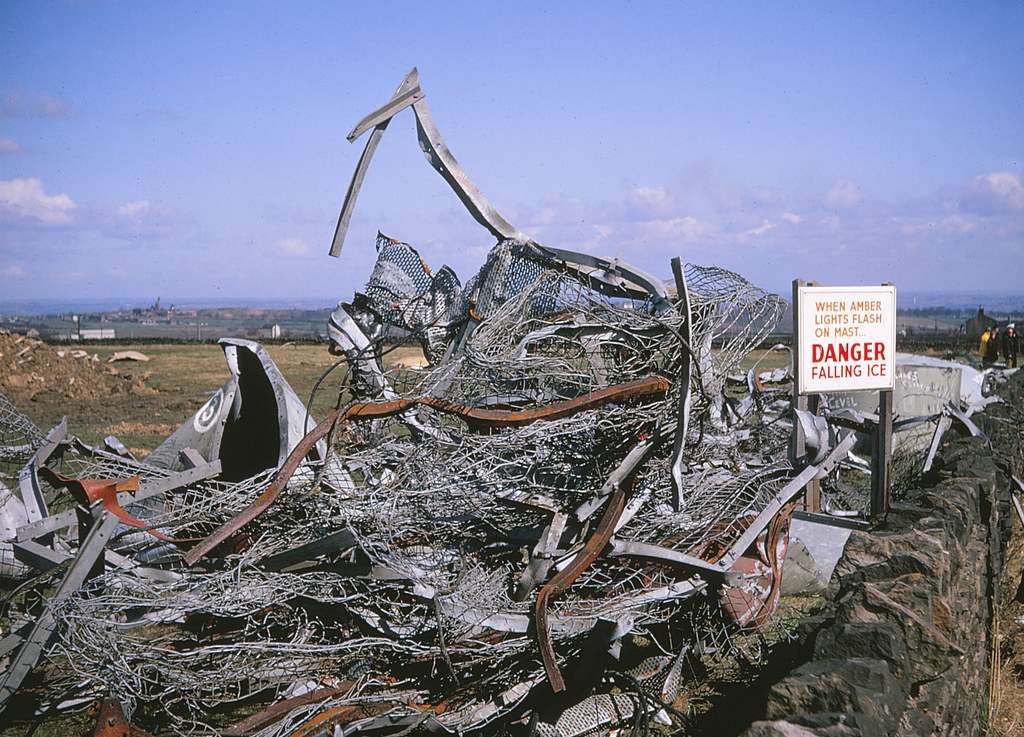TV news of a major structural collapse in Yorkshire failed to reach the people directly affected by it on March 19th, 1969 – it was their titanic TV transmitter mast which had toppled!
The tubular steel mast at Emley Moor, near Kirklees, West Yorkshire, was the region’s most visible landmark. Standing 1,266 feet high, it was, at that time, one of the world’s tallest free-standing structures, held upright by a series of thick steel guy wires.
T he first mast at the site had been in place since the earliest days of television broadcasting, but stood just 443ft tall and provided patchy transmission of black and white signals only. The new and much improved mast was built in 1966 in readiness for the start of colour transmissions. It was built from curved steel segments bolted together to form a tube that was nine feet in diameter and 902ft long, surmounted by a 315ft steel lattice section and a capping cylinder.
he first mast at the site had been in place since the earliest days of television broadcasting, but stood just 443ft tall and provided patchy transmission of black and white signals only. The new and much improved mast was built in 1966 in readiness for the start of colour transmissions. It was built from curved steel segments bolted together to form a tube that was nine feet in diameter and 902ft long, surmounted by a 315ft steel lattice section and a capping cylinder.
In wintry weather the steel mast, built on high exposed moorland, was regularly coated in ice, with large icicles forming on its guy wires and putting extra strain on them. Heavy chunks of ice falling from the guy wires was a potential hazard so amber warning lights flashed on the tower when ice was present and warning notices were erected on Jagger Lane, which ran close to the mast and beneath some of its guy wires.
The mast designers had anticipated the ice problem and believed their design could cope with it, but on March 19th, 1969, a combination of strong winds and heavy ice build-up around the top of the mast and on its guy wires caused the sudden and unexpected collapse.
It left large sections of twisted wreckage strewn across the transmitter site and Jagger Lane. A falling guy line dissected a nearby church like cheesewire cutting through cheese and several of the transmitter buildings were also destroyed or damaged. Thankfully no-one was injured.
Several million people in the region suddenly saw their TV screens go blank. At the time there were just three channels – BBC1, BBC2 and ITV. Only a partial BBC1 service remained in some parts of the region, broadcast from the nearby Holme Moss transmitter, which provided limited coverage on the VHF waveband.
Once the wreckage was cleared and the site declared safe, efforts to restore TV coverage began almost immediately. The Independent Television Authority (ITA) owned a 200ft tall collapsible emergency mast which was brought to Emley Moor from Staffordshire. It restored some service and around 2.5 million viewers had their ITV signals back within four days. The BBC sent a mobile mast on an outside broadcast van which restored a restricted BBC2 colour service within two days.
The ITA then bought a larger 669ft temporary mast from a Swedish company and hired a crew of Polish riggers to erect it, all done in under 28 days at a cost of £100,000. It came into service on April 16th, but still couldn’t transmit good quality signals to the region’s outlying areas. Some weeks later the BBC erected a 300ft mast with more antennae, improving coverage until a permanent replacement mast could be built.
Construction began later that year slightly southwest of the collapsed tower. To avoid a similar fate, it was a tapered cylindrical pillar built of reinforced concrete and standing 902ft tall. On top of that was a 180ft steel lattice mast to carry the antennae which, together with the cap, gave an overall height of 1,084ft. That made it the tallest freestanding structure in the UK and the third tallest in Europe, with a seven-minute lift ride inside the concrete pillar to reach the ‘tower room’ at the top.
The mast’s foundations penetrate 20ft into the ground and the whole structure, including foundations, weighs 11,200 tonnes. It came into service on January 21st, 1971, with the temporary transmitters then dismantled. In 2002, English Heritage granted Grade II listed building status to the Emley Moor Transmitter. Although it isn’t open to the public, there is a viewing area off the main road that runs past it.
The collapse of the previous tower caused serious concern at other UK transmitter sites with similar masts. An official inquiry blamed a particular type of oscillation caused by a low but steady wind speed, combined with ice stressing the mast’s guy wires. Modifications were made to similar masts at Belmont in Lincolnshire and Winter Hill in Lancashire (now Greater Manchester), including hanging 150 tons of steel chains inside the tubular structures to prevent them oscillating. Neither of these modified masts collapsed.
One beneficiary of the Emley Moor Transmitter collapse was Huddersfield Sailing Club, which salvaged and converted a section of the collapsed tower for use as a racing control tower. Various ‘livestock shelters’ also appeared on farms in the locality, made from surprisingly robust, if a little battered, tubular steel.
